5 Mythological Superheroes Who Could Star in Marvel Movies
Superheroes are nothing new, they were praised throughout antiquity. We present 5 Goddesses who could be the next movie legends!
Candy Bedworth 27 June 2024
Since Auguste Toulmouche’s 1866 masterpiece The Reluctant Bride recently captured the internet’s attention, discussions about female rage have surged alongside it. Despite being painted 158 years ago, the painting resonates deeply with women worldwide, portraying a familiar blend of stifled anger, resigned dismay, and seething resentment—that consuming frustration or hurt left simmering a while too long, about to boil over.
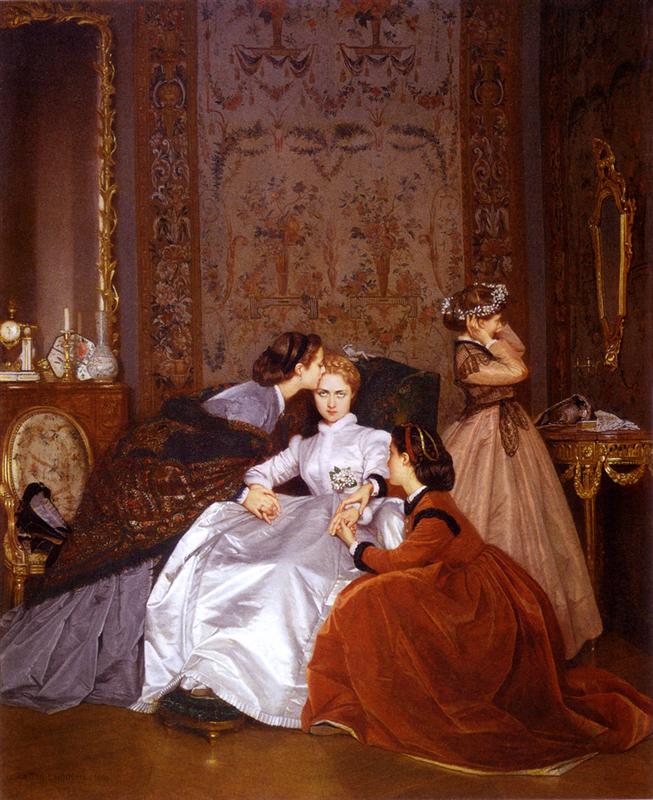
Auguste Toulmouche, The Reluctant Bride, 1866, private collection. Wikimedia Commons (public domain).
While Toulmouche conveys these sentiments through the woman’s eyes, her body remains static and anchored. Yet, across centuries, numerous artists have tackled the theme of female rage, encapsulating the unique anger born from pain particular to the experience of womanhood. Their interpretations range from overt fury to contemplative despair. This article explores such artworks, capturing the myriad expressions of female rage.
Anger is an assertion of rights and worth. It is communication, equality, and knowledge. It is intimacy, acceptance, fearlessness, embodiment, revolt, and reconciliation. Anger is memory and rage. It is rational thought and irrational pain.
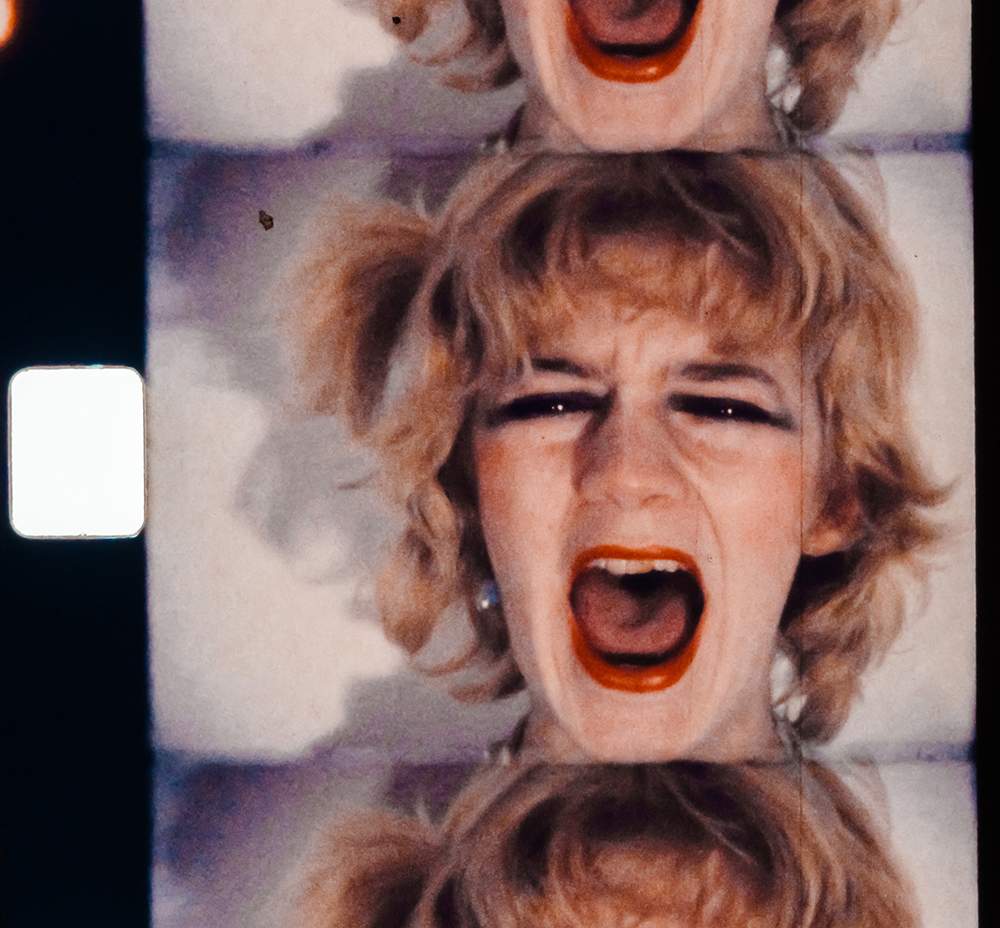
Gina Birch, still from Three Minute Scream, 1977, Tate Britain, London, UK.
Gina Birch, feminist artist and founding member of post-punk band The Raincoats, depicts female rage pointedly in an audiovisual of her looking directly into the camera and screaming continuously for three minutes. With unadulterated expression, Birch responds to the casual and overt sexism that women endure in all aspects of life.
Featured in Tate Britain’s temporary exhibition Women in Revolt! Art and Activism in the UK 1970-1990 (November 2023-April 2024), the recording plays on a loop, filling the gallery with a glorious gospel of feminine frustration. The piece is featured as part of the exhibition’s display of feminist artworks in the seminal era of feminist art in Britain.
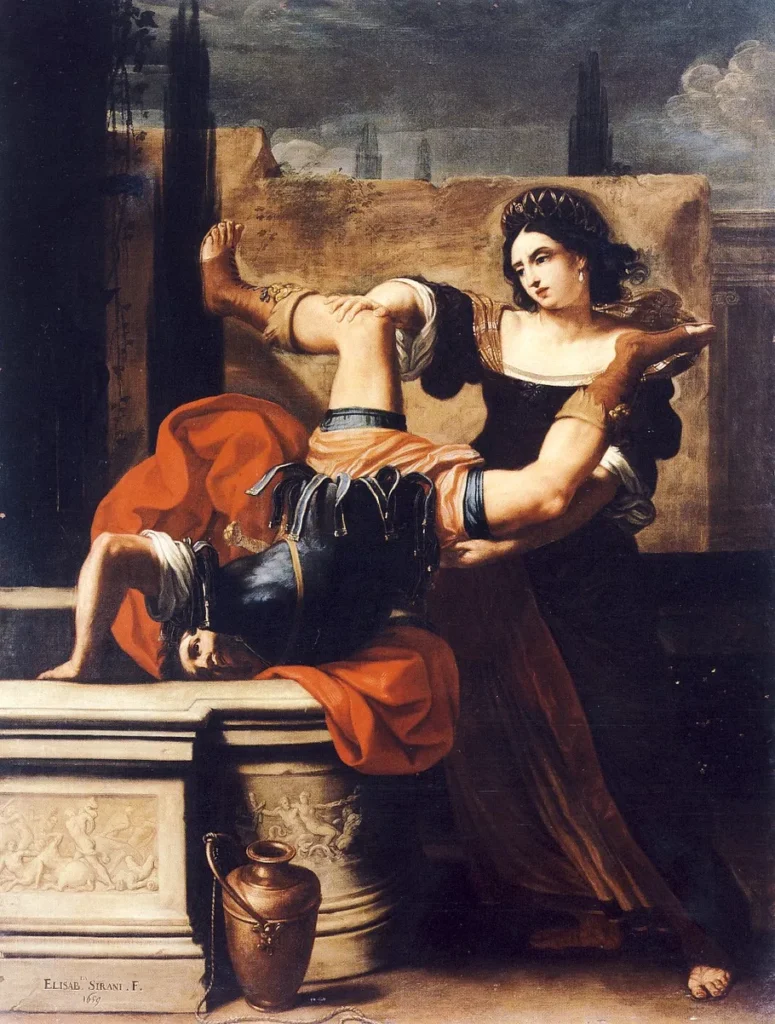
Elisabetta Sirani, Timoclea Killing Her Rapist, 1659, National Museum of Capodimonte, Naples, Italy.
Anger is freedom, independence, expansiveness, and entitlement. It is justice, passion, clarity, and motivation. Anger is instrumental, thoughtful, complicated, and resolved. In anger, whether you like it or not, there is truth.
Rage Becomes Her: The Power of Women’s Anger
The antipathetic aggression expressed by the protagonist in Elisabetta Sirani‘s painting, Timoclea Killing Her Rapist (1659), screams of exploding anger and poetic justice. Timoclea is depicted as resolutely pushing the perpetrator to his demise, reversing male dominance and hierarchy as he tumbles beneath her.
The story follows that Timoclea continued to drop rocks on her rapist until he met his brutal end. Reflecting the pain and subsequent violent rage experienced at the hands of male sexual violence, the painting marks a poignant expression of women’s revenge within Italian Baroque art.
This is underscored by Sirani’s brilliance, who uplifted other female painters throughout her short life. She established a women-only art school and dedicated her work to depicting the emotional range of women and strong female characters.
Tracey Emin expresses female pain with provocative eloquence. Her themes of rape, abortion, heartbreak, and loneliness scream intensity of emotion, passionately expressed through jagged brush strokes scrawled over delicate line-drawn figures and erratic text. Emin’s oeuvre cathartically captures the complexity of female desire, pain, loss, longing, and fury by communicating deep-rooted rage and lingering sadness through the rawness of the exposed body.
Artemisia Gentileschi’s earlier version of Judith Beheading Holofernes was painted in 1612-13, following the artist’s own traumatic experience of rape. The scene in the painting illustrates the biblical story from The Book of Judith, reproduced by many artists, notably Caravaggio. However, Gentileschi uses the story as a mirror to her pain, rage, and fantasies of revenge.
As a result, the composition of the painting highlights her aim to demonstrate the physical exertion involved in forcefully holding the perpetrator down and killing him with aggression and determination, mirroring the act of sexual coercion. By depicting Judith as pushing Holofernes’ face away from her, Gentileschi highlights how, in committing violence, the identity and personhood of the victim are brutally diminished and purposefully neglected in the cold satisfaction of the act.
Anger is the demand of accountability. It is evaluation, judgment, and refutation. It is reflective, visionary, and participatory. It’s a speech act, a social statement, an intention, and a purpose. It’s a risk and a threat. A confirmation and a wish.
Rage Becomes Her: The Power of Women’s Anger
The Tantric goddess Kali represents the warrior woman, the mother, and the revolutionary.
Using a palette of bold colors, Raja Ravi Varma has depicted Kali in her rageful form, incorporating the traditional iconography of the Hindu goddess: she is sticking her tongue out, holding a decapitated head, and wears a string of severed heads around her neck. Wielding a bloody machete, she is mounted on yet another unfortunate, specifically, her husband and the god of destruction, Shiva.
Kali expresses female rage with fearsome confidence and composure. However gory, this manifestation of Kali represents the conquering of evil and the protection of the innocent, with the bloody corpses symbolic of ignorance and infatuation. The painting was produced 30-40 years following the political reclamation of Kali as the protective Mother Goddess.
During the 1870s and 1880s, Bengali people were oppressed by the British Empire and turned to indigenous belief systems to shape their national identity. In protest, followers of Ramakrishna called themselves “the Army of the Mother.” They spread Kali’s fearsome influence across the nation, linking the Indian homeland with the presence of the Mother goddess. Poets, playwrights, and artists infused traditional myths about the Mother with contemporary political interpretations and deeper emotional resonance of the feminine desire to protect her people against subjugation and systemic violence.
Sutapa Biswas depicts a modern interpretation of Kali regarding the treatment of South Asian women by Western society, the political climate of the 1980s, and the oppression of women. Her anger is directed towards white male dictators, who represent the evil in the world that she wishes to protect oppressed people from. In a direct reference to Gentileschi’s depiction of female rage, her painting Judith Beheading Holofernes (c.1620) is printed on the red flag Kali is holding, demonstrating her acknowledgment of the lineage of female artists who have also sought to express rage against their violent subjugation.
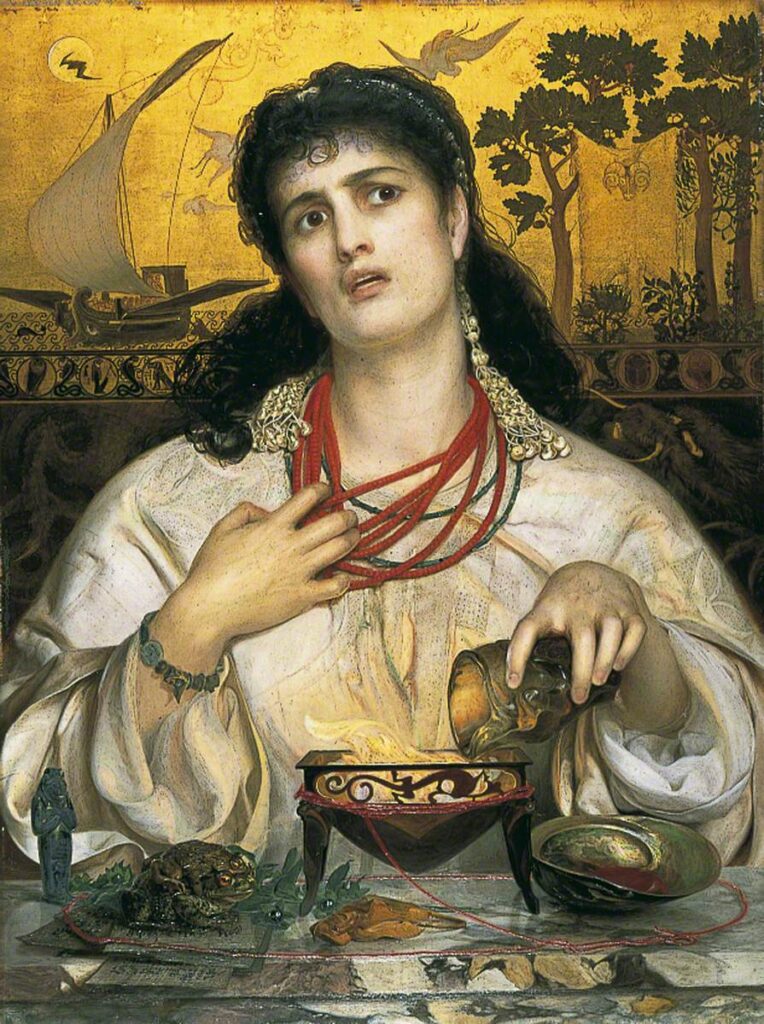
Frederick Sandys, Medea, 1866-1868, Birmingham Museum and Art Gallery, Birmingham, UK.
The tale of Medea from Greek mythology resonates as a narrative of ruthless retribution provoked by betrayal. Medea, born to the King of Aeëtes of Colchis, married Jason, the son of Aeson, after aiding him in his quest for the Golden Fleece. She employed her magical powers to safeguard his life, even killing her brother to lead Jason to success.
A decade and two sons later, Jason’s treachery unfolds as he commits himself to marry Creusa, the daughter of King Creon. He asserts the illegitimacy of his union with Medea due to her foreign origin. Having devoted her all to Jason, Medea is consumed by fury and resolves to reclaim what is rightfully hers. In a devastating act of vengeance, she sacrifices her children, Jason’s betrothed, and King Creon, thus obliterating his lineage and tarnishing his legacy.
Sandys explores the story’s themes of female rage, sorcery, and infanticide by depicting Medea’s evident pain rather than through her typical representation as a femme fatale. Creating the impression that Medea’s sacrificial acts parallel the sacrifices she made for Jason, she crafts the potion used in her murders with a tortured expression.
Further illustrating Medea’s inner conflict, Sandys depicts her tugging at the coral necklace around her neck, a gem typically associated with the protection of children. The two toads in the left corner may symbolize Jason and Creusa’s deceit and the grotesque acts that precipitate Medea’s cruelty.
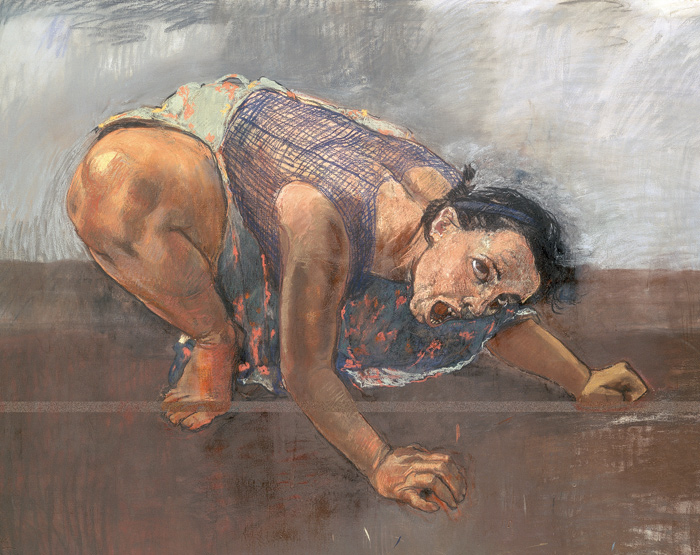
Paula Rego, Dog Woman, 1994, Victoria Miro, London, UK.
Paula Rego’s artworks encompass themes relating to childhood, sex, fairytale, and trauma. By rejecting the depiction of women according to conventional beauty standards, Rego forms a particularly distinctive style that is often surreal, disturbing, and emotionally bold.
Unapologetic women are central to Rego’s oeuvre, a motif encapsulated by her oil pastel drawing, Dog Woman (1994). It overtly challenges the societal expectation placed on women to exhibit ladylike and docile behavior. However, the woman as a dog also refers to the socially and politically oppressive environment in which Rego grew up and subsequently learned obedience and subservience. This “dog woman” rejects such treatment. She is aggressive, snarling, feral, and tormented, yet nonetheless unashamed in her refusal to comply with the social standards that oppress her.
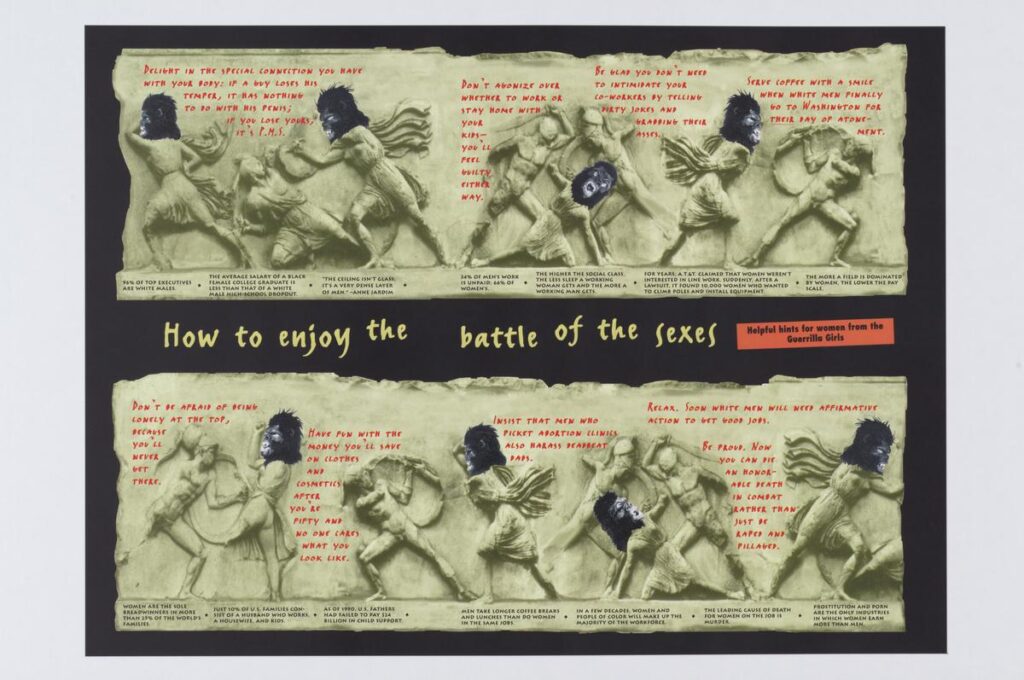
Guerrilla Girls, Battle of the Sexes, 1996, Tate Modern, London, UK. © Guerrilla Girls.
[Anger] is both powerlessness and power, palliative and a provocation. In anger, you will find both ferocity and comfort, vulnerability and hurt. Anger is the expression of hope.
Rage Becomes Her: The Power of Women’s Anger
The Guerrilla Girls are famous for disrupting the patriarchal structures of the art world and society at large. In undiluted rage, they eloquently highlight systems of injustice through their art, protests, and rallying posters. They challenge the notion of individualism and ownership by concealing their identities with gorilla masks, as illustrated in this print, The Battle of the Sexes (1996).
Using the imagery of an Ancient Greek frieze, a civilization recognized in the art world as superior, the Guerrilla Girls adorned the classical figures (in the throws of a battle) with their iconic mask. Surrounding them are inscriptions listing the injustices and challenges that women, people of color, and working-class people face in the context of white, elitist, and patriarchal dominance. Witty comments addressing themes of unequal parenting, an unbalanced job market, and male violence are backed up by supporting evidence along the bottom.
Their statements include “Don’t agonize over whether to work or stay home with your kids – you’ll feel guilty either way,” “insist that men who picket abortion clinics also harass deadbeat dads,” “the average salary of a black female college graduate is less than that of a white male high-school dropout,” “the more a field is dominated by women, the lower the pay scale,” and “prostitution and porn are the only industries in which women earn more than men.”
The Guerrilla Girls not only express defiance towards such systems but masterfully stir feelings of female rage within the viewer, as evidently, there is a lot to be very angry about.
DailyArt Magazine needs your support. Every contribution, however big or small, is very valuable for our future. Thanks to it, we will be able to sustain and grow the Magazine. Thank you for your help!